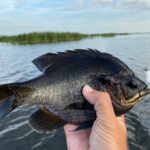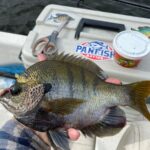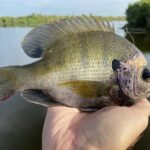We’ve all heard the horror stories of farm-raised Tilapia and are aware of the poor reputation they have… but what about Tilapia in natural ponds, rivers, and lakes?
What do tilapia eat in the wild, and are they good to eat?
In this article ill answer those questions and more…and you may be quite surprised!
Table of Contents
What do Tilapia Eat in the Wild?
Tilapia are technically omnivores, but in the wild, they are almost exclusively vegetarians. Stomach content analyses of blue, Nile, and Mozambique tilapia show they are largely herbivorous. Their diet is mostly composed of aquatic plants, algae, and diatoms.
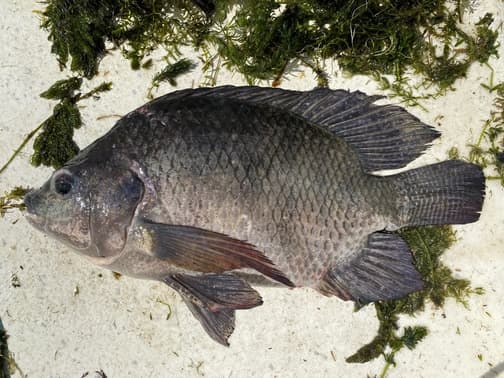
A small percentage of their diet also includes microcrustaceans, aquatic insects, and fish eggs. In habitats with a shortage of plants and algae, tilapia have the potential to shift their diet to include more proteins.
They may feed off the bottom for worms or shrimp. They may even chase and consume small live fish like mosquito fish or shiners.
Tilapia Feeding Habits
Tilapia primarily feed on plants and algae. They graze on the bottom and on the surface of the water. Often, tilapia can easily be observed meandering around the shallows looking for food and picking up pieces of plants and algae.
What Kind of Plants do Tilapia Eat?
Tilapia eat a wide variety of plants in the wild, they really aren’t picky. They’ll eat native plants like eelgrass, Cabomba, and duckweed, but they will also eat invasive plants like elodea, water hyacinth, and Brazilian water weed.
When homeowners cut their lawns, grass clippings often find their way into their neighborhood ponds.
It is pretty common to observe tilapia feeding on the grass clippings floating on the surface of the water.
What Do Tilapia Eat In Ponds?
Tilapia are common in both residential and naturally occurring ponds throughout their range. They eat a mainly herbivorous diet of whatever vegetation and detritus is available.
Is it Safe to Eat Wild Caught Tilapia?
Wild-caught tilapia can be good eating, but you should be selective with where you harvest from. Tilapia are very tolerant of polluted waters, so you should be careful to avoid eating fish from polluted water.
Small bodies of water near cities and neighborhoods, such as retention ponds and canals are very susceptible to pollution from pesticides and fertilizers. Avoid harvesting tilapia from these areas.
Larger bodies of water, such as large lakes, natural wetlands, and rivers are less likely to be polluted but are still not immune to pollution.
Check with your local state fisheries department for the recommended guidelines for eating wild fish.
There are often sources such as fish consumption advisories that are published by the state. They advise anglers on possibilities of contamination in watersheds, and which fish species are more likely contaminated by heavy metals, pesticides, and other chemicals.
Related: Are Carp Good To Eat? Why The Poor Reputation?
Which is Better to Eat: Farm Raised or Wild Tilapia?
The answer really depends on the water quality.
Tilapia farming was really popular when it first started. However, as the industry grew, some poor farming practices gave tilapia a bad reputation.
Tilapia are very hardy fish and are tolerant to polluted water, so many farms were raising tilapia in overcrowded and polluted ponds.
What Do Tilapia Eat In Fish Farms?
Farm-raised Tilapia are often fed a pelletized diet, consisting of soy, corn or other inexpensive grains. These are usually mixed with vitamins and fishmeal.
Some fish were exposed to chemicals or were fed an unnatural diet to grow faster. Also, farmed fish in overcrowded ponds are more susceptible to illnesses and are often given antibiotics.
Due to these poor farming practices, there are some consumption advisories warning against eating farmed tilapia.
You have to be careful with wild tilapia too! Tilapia are great invaders of eutrophic and polluted habitats, so you should be selective with your harvest. Avoid polluted bodies of water!
The choice is up to you and your comfort level. If you can find a farm that raises tilapia in a clean environment, I say go for it! If you want to catch your own tilapia for dinner it will be just as good!
What Are The Different Types Of Tilapia?
Tilapia is a common name for large, mostly herbivorous cichlids native to Africa. There are many different species known as tilapia, but only a few species have become common and widespread in North America. These are the Blue tilapia (Oreochromis aureus), Nile tilapia (Oreochromis niloticus), and Mozambique tilapia (Oreochromis mossambicus).
These tilapia species are common in the fish farm and aquaculture industry. As a consequence, they were introduced to many places around the world.
These three Oreochromis species are very similar in appearance and frequently co-occur in most of their non-native ranges. As a result, these three species hybridize often making identification even more difficult.
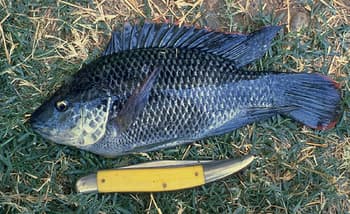

Several other species of tilapia were introduced into the United States.
In South Florida, you can find some of the more exotic tilapia species including the spotted tilapia (Pelmatolapia Mariae), hornet tilapia (Heterotilapia buttikoferi), and blackchin tilapia (Sarotherodon melanotheron).
In California, there is also the redbelly tilapia (Tilapia zillii).
All tilapia species are considered invasive species in North America, and they are harmful to native species and natural habitats.
Related: Fishing For Invasive Fish In Florida- Species Guide & Tips
Tilapia Habitat
Tilapia inhabit many different habitats including lakes, ponds, rivers, and creeks. They thrive in eutrophic habitats with lots of vegetation and algae. They are especially prominent in disturbed or artificial habitats, such as retention ponds and canals.
Tilapia can also be found in large rivers and wetlands, such as those seen in the St. Johns River in Florida.
Here there is an abundance of plants and algae for tilapia to eat, and they have taken over parts of the river (which has made them very popular targets for bowfishing!)
The thermally stable springs along the St. Johns River provide refuge for tilapia during cold winters.
Tilapia are tropical fish and cannot survive in cold water temperatures for extended periods of time.
What are the Best Baits for Tilapia?
As we have already discussed, tilapia are herbivorous, but what is the best bait to catch tilapia?
In my experience, I’ve found that the best bait is bread! Any bread works. Just chum a bit in the water and the tilapia will come and eat it off the surface or on the bottom.
For some reason, most herbivorous fish just cannot resist bread. I really like to use cheap white bread because they pack better onto the hook. Chumming some bread in one spot is a very effective way to attract and catch tilapia.
While not as effective as bread, live worms work for tilapia too. I’ve caught many tilapia just fishing live worms for whatever bites.
Other bait options include plant foods like sweet peas and corn. If you’ve ever fished for carp, bait fishing for tilapia is similar.
Perhaps the most overlooked bait is plants or algae, the natural favorite food of tilapia! If you can find a good mat of green algae, just put a ball of it on your hook and let it float along the shallows. If a hungry tilapia sees it, they’ll come right up and eat it off the surface!
Can You Catch Tilapia on Artificial Lures?
Yes, artificial lures trigger tilapia’s aggressive and territorial instincts! Tilapia hit artificial lures quite often, especially during the spawning season.
Tilapia are cichlids, and like most cichlids, they are very territorial during their spawning season.
Tilapia start their spawn in early spring and continue through the summer. They make large beds and defend their nests from other fish and whatever invades their territory.
See Also: How To Catch Mayan Cichlids – Full Species Guide & Tips
What are the Best Lures for Tilapia?
Small jigs and spinners work best for tilapia, especially around their spawning season.
The same-sized lures you use for bluegill or crappie are also perfect for tilapia. I like to use 1 to 2-inch straight tails on a 1/32 or 1/16th oz jig head.
Beetle spins and rooster tails work incredible too! I catch so many tilapia on spinners even when they aren’t spawning. There is something about the flash and vibration that just triggers an aggressive strike from them.
Fly fishing can also be effective for tilapia. Most panfish-sized flies are effective such as wooly buggers, streamers, and bead heads.
If you can see the tilapia, you can often trigger them to strike by moving the lure into their field of view.
From early spring through summer, you can actually catch tilapia on beds. Just like bedding bass and bluegill, they will hit lures while they defend their nests.
You May Also Like: How to Catch Koi Fish (And Are They Edible?)
If you haven’t guessed yet, I love fishing and everything about it!
To learn more about why I started Panfish Nation, visit the About page and follow along on Social Media:


Download a copy of my FREE Lure Color Selection Chart & Knot Guide!
Stay up to date with fishing reports, tackle reviews, industry news, and much more! We respect your privacy, unsubscribe at any time.
Related Posts
- Crazy Facts About the World Record Crappie
- What Size Hooks for Smallmouth Bass? Quick Guide
- Large and in Charge-Mouth: 10 of the Best Bass Lures of All Time (And Where to Buy Them)
- Emperor of the Sun(fish): What You Need to Know About the World Record Bluegill
- Coppernose Bluegills: How They’re Different from Common Bluegill
- Bluegill vs Brim: Differences & Terminology, Explained!




